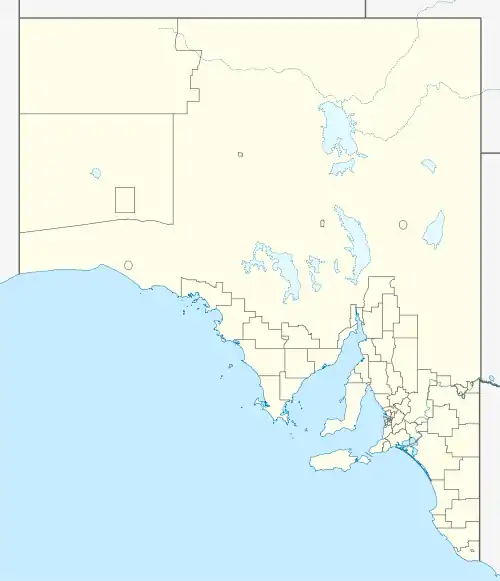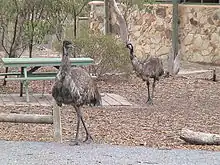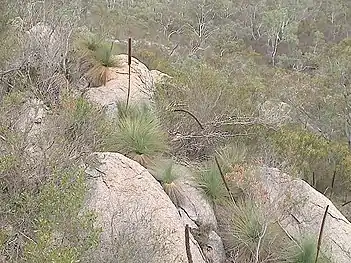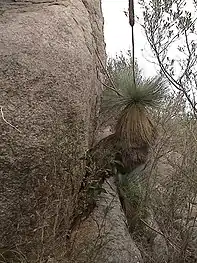Para Wirra Conservation Park
Para Wirra Conservation Park (formerly Para Wirra Recreation Park and Para Wirra National Park) is a 1,417-hectare (3,500-acre) protected area located in the foothills of the Mount Lofty Ranges in the northern end of the Adelaide metropolitan area in South Australia.[6] The conservation park is part of a larger, 2,573-hectare (6,360-acre) block of contiguous native vegetation, the remainder of which is owned by PIRSA Forestry,[7] SA Water and private landholders.[5]
| Para Wirra Conservation Park South Australia | |
|---|---|
IUCN category III (natural monument or feature)[1] | |
 Recreation park's lake and island | |
 Para Wirra Conservation Park | |
| Nearest town or city | Williamstown[2] |
| Coordinates | 34°40′50″S 138°49′48″E[1] |
| Established | 21 June 1962[3] |
| Area | 15.12 km2 (5.8 sq mi)[4] |
| Visitation | 60,000 (in 1993)[5]:15 |
| Managing authorities | Department for Environment and Water |
| Website | Para Wirra Conservation Park |
| See also | Protected areas of South Australia |
Description
Para Wirra Conservation Park is located within the localities of Barossa Goldfields, Humbug Scrub, Williamstown and Yattalunga about 40 kilometres (25 miles) northeast of Adelaide CBD and 19 kilometres (12 miles) southeast of Gawler.[2][8] The other close townships to the park are One Tree Hill to the south and Williamstown to the east.
Climate
The climate is Mediterranean maritime, influenced by south westerly winds with approximately 79% of the total rainfall occurring in the months from April to October, inclusive.[5]
Topography
The park ranges in altitude from 137 metres (449 feet) above sea level immediately below Devil's Nose to just over 328 metres (1,076 feet) asl in the south eastern corner of the park. 76% of the park lies above the 24 metres (79 feet) contour.[9] The landform of the park has been described as "a hilly upland with broad crests and dissected slopes" (Lauet al et, 1977). The northern section is a dissected plateau due to the South Para River, which has formed steep sloped valleys and narrow ridge tops; the central reserve area is an undissected plateau; and the southern area is dominated by Mack Creek.[5]
Geology
Para Wirra Conservation Park lies entirely within an inlier of crystalline basement rock which extends southwards to Torrens Gorge. It is part of a more extensively exposed Precambrian rock mass, the oldest in the Mount Lofty Ranges. In the extreme west of the park there are undifferentiated metamorphic, mostly very micaceous rocks (schists), and gneisses. A zone of distinctive layered or banded quartz-feldspar rich rocks (gneisses) extends though the central portion of the park. In the extreme east there is another conspicuous rock type (augen gneiss) which is distinguished by the presence of "eye" structures (usually of feldspar) up to 2.5 cm in length, indicative of greater shearing.[5]
Soils
There appear to be 3 principal soil types in the park: duplex soils with yellow-grey clay horizons in the southern section of the park, duplex soils with red clay horizions in the north and coarse textured uniform soils on the steep slopes and rockly ridges. The South Para River has limited soil developments and consists of alluvial sands and gravels. All soils are acidic.[10]
Purpose
- The preservation and management of wildlife
- The preservation of historic sites, objects and structures of historic or scientific interest within the reserves
- The preservation of features of geographical, natural and scientific interest
- The destruction of dangerous weeds and the eradication or control of noxious weeds and exotic plants.
- The control of vermin and exotic animals
- The control and eradication of disease of animals and vegetation
- The prevention and suppression of bushfires and other hazards
- The encouragement of public use and enjoyment of reserves and education in, and a proper understanding and recognition of their purpose and significance[5][11]
Importance
Para Wirra Conservation Park is not only important as an educational resource, but also for its conservation and recreation value. The boundary of the conservation park is contiguous with, and forms part of a 2,573 hectares (6,360 acres) block of native vegetation. As only twenty six percent (26%) of the Mount Lofty Ranges remains uncleared, a block of native vegetation of this size is important in terms of its representativeness of vegetation types, for the maintenance of diversity of animal and plant species, maintenance of water quality, and as a valuable recreational resource for the community. Para Wirra Conservation Park also provides a range of recreation opportunities consistent with its conservation significance and its importance and proximity to the expanding population of the northern metropolitan area.[5]
History
Land within the conservation park was first given protected area status on 21 June 1962 when it was proclaimed under the Crown Lands Act 1929 as the Para Wirra National Park,[3] taking its name from the historic cadastral division which in lay, the Hundred of Para Wirra. The national park was officially opened on 24 September 1963 by the then Premier of South Australia, Sir Thomas Playford and was the second reserve in the state to be proclaimed as a national park.[5]:2 On 27 April 1972, the national park was reconstituted as a recreation park.[12] This reconstitution reflected the park's role as a natural area catering for a wide range of recreational activities. On 2 November 2015, Environment Minister Ian Hunter announced that to better recognise and protect the recreation park's natural and heritage values, it would be upgraded to Conservation Park status.[13] The recreation park was abolished on 19 May 2016 and on the same day, its land holding was constituted as the Para Wirra Conservation Park.[14][15]
Prior use of the land
The conservation park takes its name from what are believed to be two local Aboriginal words; Para meaning "river" and Wirra meaning "forest". There are several sites of Aboriginal significance within the conservation park, but the area was thought to have been occupied by the Peramangk tribe prior European settlement.[16] Recent findings are currently under investigation.[17]
Flora and fauna
Flora
Para Wirra Conservation Park is predominately covered in eucalyptus; however there is a wide variety of vegetation types. Some of these include: - Woodland - Open Woodland (low open woodland) - Low open forest - Closed scrub - Eucalyptus open scrub - Melaleuca uncinata open scrub - Melaleuca uncinata closed heath[5]
Fauna
Para Wirra Conservation Park is crucial in conserving the native wildlife as much of it has been adversely affected by past agricultural and mining practices.[18]
Mammals
Para Wirra Conservation Park supports a large population of western grey kangaroos and sometimes euros can be seen. Other native animals present but not frequently observed in the park include the small nocturnal yellow-footed antechinus, the ant and termite eating short-beaked echidna, the common ringtail possum and the brushtail possum.
Birds

There are over 120 species of birds recorded in the conservation park. These include the emu which was introduced into the park in 1967. In the aquatic areas of the park birdlife includes the grey teal, Australasian grebe and cormorants. The South Para river and nearby woodland areas support birds such as white-faced herons, black ducks, white-browed babblers, black-chinned honeyeaters and eastern spinebills. A range of birds occur throughout the park including such species as the common bronze wing, scarlet robin, black-faced cuckooshrike, restless flycatcher, grey currawong, little raven and the New Holland honeyeater. white-throated treecreepers, brown treecreepers and white-winged choughs are observed in the woodland areas while laughing kookaburras, red-rumped parrots and peaceful doves prefer the grass and woodland areas. In areas of dense groundcover family groups of superb fairywrens search for food. Flitting in the open areas are jacky winters and yellow-rumped thornbills.[9][18]
Reptiles and Amphibians
There are 38 recorded reptiles and amphibians within Para Wirra Conservation Park. These include the long-necked tortoise, marbled gecko, tree dtella, bearded dragon, the shingle back, common grass skink and eastern blue tongue lizard. Only 5 species are amphibians: the brown tree frog, bull frog, spotted grass frog, Bibron's toadlet and brown froglet.[18] The yellow faced whip snake, brown snake and the red-bellied black snake have also been sighted in the park.[5]
Recreational uses
Trails
Walking is one of the best ways to discover the beauty of Para Wirra Conservation Park. All trails are graded and timed. Trails include spectacular, invigorating and enlightening walks around the lakes, the goldfields, valleys, open woodland and rivers. More information can be obtained from pamphlets on Para Wirra Conservation Park from DEWNR. The contact details are listed below under the last heading in this article.[19]
Programmes in place
Programmes in place at Para Wirra Conservation Park include:[20] weed control (namely African bridal creeper and boneseed), vermin control (preventing over grazing by feral goats and kangaroos), and revegetation programmes aimed at re-establishing indigenous plant species.[5]
Affiliated groups
Affiliated groups with the Para Wirra Conservation Park, other than the conservation park's manager Department of Environment, Water and Natural Resources (DEWNR), include The Friends of Para Wirra (the major group). They meet on the first Wednesday and third Saturday of every month, starting at 9:00 am in the Conference Centre alongside the Ranger's office.,[21] Heart Foundation Walks,[22] Barossa Goldfields Society,[23] Tintookies Orienteers,[24] ASSA,[25] and various other groups who volunteer and hold functions within the recreation park less frequently.
Guided walks and school visits
School visits, guided walks and other functions such as celebrations, meetings and volunteer activities within the park can be arranged.
Conference Centre
The Friends of Para Wirra also have a small Conference Centre for hire, named the Ted and Molly Hughes Conference Centre after a husband and wife who are valuable life members of the Friends, having provided over 20 years’ service.
Educational value
Para Wirra Conservation Park's educational value is regarded as "invaluable", because of:
- The unobstructed astronomy/star gazing (park closes at sunset)
- Weed control with volunteer opportunities
- Preservation of native flora and fauna
- Natural bush setting
- Public education of bushfire management strategies
- Raising public awareness of having a sustainable balance between native areas and urban areas
- Adjoining Education Centre[26][27]
Facilities
- Information Centre/ Ranger's Office
- Ted and Molly Hughes Conference Centre
- Barbecue sites
- Picnic areas e.g. lake area
- North Oval including a cricket pitch
- Walking trails
- Playground
- Toilets
Major attractions and activities
- Native wildlife
- Bush walking
- Sight seeing
- Goldfields heritage
- Bird watching
- Voluntary weed control (contact the Para Wirra Conservation Park Office and/or Friends group)
- Dusk walks
- Abundant flora, including some rare species such as orchids
- Motor bike riding and cycling on public roads only
- Walking pets on leash.
- Horse riding in a limited area[28][29][30]
Gallery
 Yaccas growing in crevices in granite gneiss outcrop near Lizard Rock
Yaccas growing in crevices in granite gneiss outcrop near Lizard Rock Yacca growing in crevice in granite gneiss outcrop near Lizard Rock
Yacca growing in crevice in granite gneiss outcrop near Lizard Rock
See also
References
- "Terrestrial Protected Areas of South Australia (refer 'DETAIL' tab )". CAPAD 2016. Australian Government, Department of the Environment (DoE). 2016. Retrieved 21 February 2018.
- "Search results for 'Para Wirra Conservation Park' with the following datasets selected - 'NPW and Conservation Properties', 'Suburbs and Localities', 'Hundreds' and 'Gazetteer'". Location SA Map Viewer. South Australian Government. Retrieved 23 May 2018.
- Rowe, Colin D. (21 June 1962). "CROWN LANDS ACT, 1929-1960: HUNDREDS OF PARA WIRRA AND BAROSSA-WILD-LIFE RESERVE DEDICATED_" (PDF). The South Australian Government Gazette. South Australian Government. Retrieved 22 May 2018.
Name the said reserve "Para Wirra National Park."
- "Protected Areas Information System Reserve List" (PDF). Government of South Australia. 9 March 2018. Retrieved 26 April 2018.
- "Para Wirra Recreation Park Management Plan" (PDF). Department of Environment and Land Management. December 1993. Retrieved 31 May 2018.
- Department of Environment & Natural Resources - Para Wirra Conservation Park Accessed 26 December 2015.
- "Forestry". PIRSA. Retrieved 25 March 2020.
- Para Wirra Recreation Park Demand Survey- Draft Report 8 August 1999 published by QED Pty Ltd (Quality Environmental Decisions)
- Clark, G., 1967. Birds of Para Wirra. South Australian Ornithologist. 24.119-34.
- Crichton, T., Harvey, W. and Hill, B. 1978. Soil and Vegetation Survey of Para Wirra Recreation Park. Unpublished.
- Department of Environment and Planning. 1987. A Proposal for a Metropolitan Open Space System. State Government Printer.
- "No. 56 of 1972 (National Parks and Wildlife Act, 1972)". The South Australian Government Gazette. Government of South Australia: 660 & 704. 27 April 1972. Retrieved 27 May 2018.
- News and media releases - Para Wirra upgraded to a conservation park Department of Environment, Water and natural Resources. 2 November 2015. Accessed 26 December 2015.
- "National Parks and Wildlife (Para Wirra Recreation Park) Proclamation 2016". The South Australian Government Gazette. South Australian Government. 19 May 2016. p. 1476. Retrieved 31 May 2018.
- "National Parks and Wildlife (Para Wirra Conservation Park) Proclamation 2016". The South Australian Government Gazette. South Australian Government. 19 May 2016. p. 1477. Retrieved 31 May 2018.
- Tindale, N.B. 1974 Aboriginal Tribes of Australia. Australian National University Press, Canberra.
- Lady Alice Mine Conservation Management Plan Draft, prepared by Habitable Places survey team May 2008
- Alexander, P., Evans, D., and Hill, B., 1978 Para Wirra Recreation Park-Vertebrate Fauna Survey. Unpublished.
- "Para Wirra Recreation Park" Issued by the National Parks and Wildlife of South Australia, Government of South Australia. Published by Department for Environment and Heritage, Printed April 2008
- Dahl, E (unpublished data) Project Brief – Vegetation Recovery in Para Wirra Recreation Park. Stage III: Management of Kangaroo Grazing Pressure. Para Wirra Vegetation Recovery Project.
- "Friends of Para Wirra". Friends of Para Wirra. Retrieved 27 July 2015.
- "Heart Foundation Walks". Australian Heart Foundation. Archived from the original on 8 April 2011. Retrieved 27 July 2015.
- "Barossa Goldfields Society". Barossa Goldfields Society. Retrieved 27 July 2015.
- "Tintookies Orienteers". Tintookies Orienteers. Archived from the original on 20 February 2012. Retrieved 27 July 2015.
- "ASSA". ASSA. Retrieved 27 July 2015.
- McPherson, Michelle Para Wirra Visitor Survey, Published by Department of Environment and Heritage 2002–2003
- Senior Ranger of Mount Lofty Region unpublished data and comments
- " Para Wirra Recreation Park" Issued by the National Parks and Wildlife of South Australia, Department for Environment and Heritage in conjunction with the Government of South Australia and the Friends of Para Wirra. Published by Department for Environment and Heritage, Reprint April 2002
- Weber, Delene (Sustainable Environments Research Group School of Natural and Built Environments, University of South Australia) Healthy Parks, Healthy People: Improving our Understanding of Visitors to Belair National Park, Report prepared for DEH, September 2006
- "Para Wirra Recreation Park | Adelaide Things to Do". About-australia.com. Retrieved 23 December 2011.